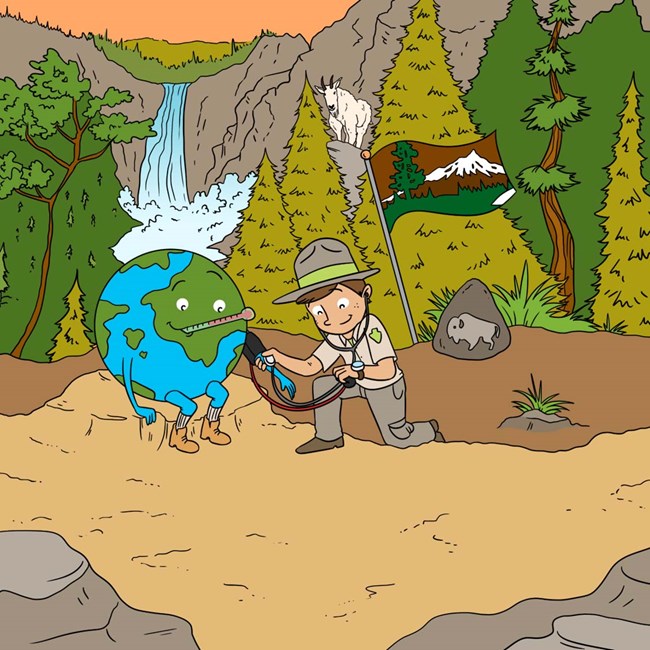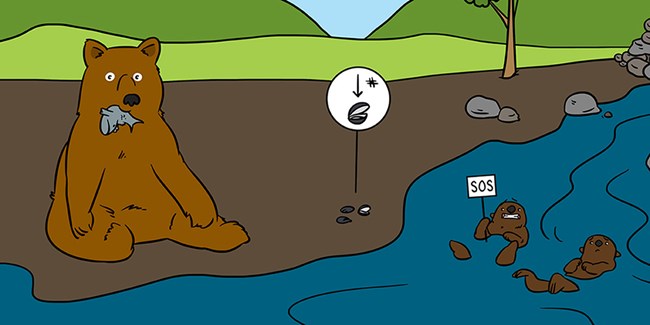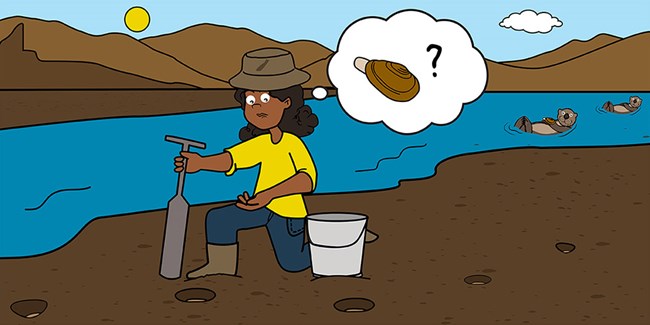
Credit: Frontiers for Young Minds
How do we know if parks are healthy? We measure their vital signs, of course! Across the country, there are 32 inventory and monitoring networks that measure the status and trends of all kinds of park resources. We're learning a lot after years of collecting data.
These articles are a part of a collection, or special issue, of Frontiers for Young Minds, an international online journal of science written for kids and involving kids in the review process. Taking the Pulse of U.S. National Parks presents what we are learning from years of monitoring plants and animals and physical conditions in parks. The articles featured here are results from Southwest Alaska parks.

Credit: Frontiers for Young Minds
Where Land and Sea Meet: Brown Bears and Sea Otters
In Katmai National Park, Alaska, we have seen changes in the number of brown bears and sea otters. The number of animals of a species a habitat can support is called carrying capacity. Even though bears live on land and sea otters live in the ocean, these two mammals share coastal habitats. Bears eat salmon, other fish, plants, clams, and beached whales. Sea otters feed on clams and other marine invertebrates. All these foods are influenced by the ocean. Recently, we have seen fewer bears but more sea otters! What changed? Many things, but several observations point to the ocean. There are fewer salmon, whales, and clams, so bears rely more on plants for food. Fewer clams mean sea otters must work harder to find food. Our studies are helping us to understand how and why carrying capacity for a given species may change over time.
Also see: sea otters and brown bears in Southwest Alaska
Coletti, H., G. Hilderbrand, J. Bodkin, B. Bellachey, J. Erlenbach, G. Esslinger, M. Hannam, K. Kloecker, B. Mangipane, A. Miller, D. Monson, B. Pister, K. Griffin, K. Bodkin, and T. Smith. 2022. Where land and sea meet: Brown bears and sea otters. Frontiers for Young Minds 10: 715993.

Credit: Frontiers for Young Minds
The Mysterious Case of the Missing Razor Clams
Oceans are changing and these changes are affecting the animals that live there. Animals respond differently to changes in water temperature, food availability, and contaminants. Those responses can be seen in their genes. A technique called transcriptomics allows scientists to see the response of an animal’s genes to its environment. We used transcriptomics to compare two populations of Pacific razor clams in Alaska (United States): one that has lots of clams and one that used to have lots but does not anymore. We were surprised when we did not find any differences in their gene responses! So, we had to think about what else might be influencing the number of clams in these two populations. As we “dug” for answers, we found out that there are differences between the populations that do not influence their genes but may impact their numbers, such as being eaten by predators.
Also see: marine intertidal invertebrates in Southwest Alaska
Coletti, H., L. Bowen, B. Ballachey, T. L. Wilson, S. Waters, M. Booz, K. L. Counihan, T. Hollmen, and B. Pister. 2022. The mysterious case of the missing razor clams. Frontiers for Young Minds 10: 715425.

Credit: Frontiers for Young Minds
Fish Ear Stones Offer Climate Change Clues in Alaska Lakes
Otoliths, also known as ear stones, are small body parts that help fish with hearing and balance. Like tree rings, otoliths form one light and one dark band per year, creating rings. These rings can be measured to understand fish growth. The wider the ring, the greater the growth. In our study, we used otoliths to understand how one fish species—lake trout—responds to rising temperature in the state of Alaska. We found that warmer spring air temperature and earlier lake ice melt were related to faster lake trout growth. This finding is consistent with other studies that link warmer water temperature and earlier lake ice melt to increased plankton in Alaska’s lakes. Together, these findings suggest that climate-driven increases at the bottom of the food web might benefit top predators like lake trout. However, the relationship between warmer temperature and faster growth may not last.
Also see: water quality in Southwest Alaska parks
Bartz, K., V. von Biela, B. Black, D. Young, P. van der Sleen, and C. Zimmerman. 2022. Fish Ear Stones Offer Climate Change Clues In Alaska’s Lakes. Frontiers for Young Minds 10:726495.
Last updated: October 13, 2022
